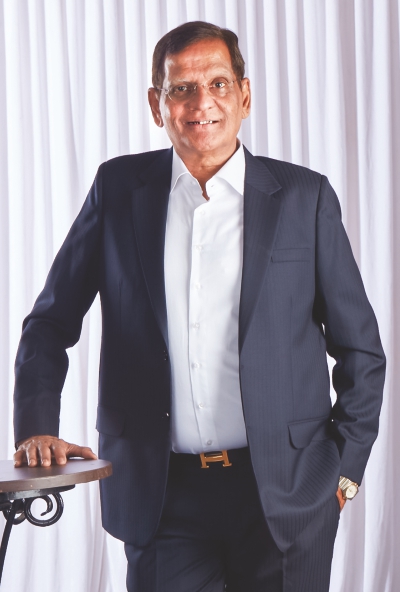RR Kabel, part of RR Global, a USD 1.25 billion conglomerate, is a wire manufacturing company spread across multiple business verticals. The company offers the widest range of premium wires and cables for various residential, commercial, industrial and infrastructural purposes.One of the leading companies in the electrical and copper industry, RR Kabel believes that the future of the industry lies in innovation and effective R&D. In a recent conversation with Wire & Cable India, Mr. Shreegopal Kabra, Managing Director and Group President, RR Group shared his views on fire safety and need for various legislations with regard to selection of right wires & cables. He also highlighted the government initiatives uplifting the electrical sector along with challenges and changes required for the industry’s growth.
Wire & Cable India: Could you tell us how the electrical industry is growing and how government initiatives are uplifting the industry?
Shreegopal Kabra: There are many market segments which have started growing in India, one of these being the real estate market. The real estate market continues to grow and as a result electrical consumption is ever-increasing. In the electrical market, product quality is extremely important. Even the Indian government is contributing a lot to the real estate market, with their “Housing for all” scheme. Moreover, there is a general environment in the country where people wish to own houses, and in order to facilitate this the government has also created the “Power for all” programme. India has around 7 lakh villages and even today 30 percent of our population lives in places where they cannot get proper food, clothing and housing. Gradually, electricity will reach these people and even people with lower pay grades will start saving up and bring electrical appliances into their houses. Through an ongoing government scheme, the government provides 90 percent cost subsidy for solar submersible pumps for farmers.
Through these pumps, the farmer gets a supply of both electricity and water. This is a great initiative which will help farming to grow in the future and help our country in retaining the title of an agricultural country. Furthermore, there is a lot of ongoing and upcoming growth in our country. The government is building medical colleges in every district, the Ayushman Bharat Yojana, providing people with homes, building 3 crore toilets all over India, and a general development in the country which has helped in the growth of the Indian economy. And any kind of growth in the country means growth for the electrical sector and major consumption of the electrical sector is for wires and cables.
Watch: RR Kabel | Solar Cables | Solar Plant | Renewable Energy
WCI: What are the major challenges being faced by the Indian electrical industry?
SK: We believe that India’s goal for a USD 3 trillion economy will be achieved before estimated time seeing our current economic and political conditions. However, along with growth we must simultaneously focus on quality and safety in the electrical sector. The quality of electrical products is decreasing day by day, whether it be due to preference given to L1 suppliers or just a general lack of knowledge of the industry. Firstly, there are multiple high rise buildings being built in India, but our fire brigades have no infrastructure in place to extinguish fires above the 20th floor.This is a big concern, especially in cities like Mumbai with buildings having over 70-80 floors. PVC and LS0H wires are easily flammable, smoke producing wires. Still such wires are being used in prestigious projects in India like Central Vista. The class 2 conductor flexible wire in itself is a technically wrong product. Initially, these house wires were reserved for small-scale industries but later these wires were turned into flexible wires and manufactured in 90m packaging, and that trend is still being followed in the industry. These multi strand wires are not used as house wires in any country except India. FRLS wire, which is manufactured in India, is another similar exception. Moreover, most electricians lack the proper knowledge, tools and skill required for efficient functioning of wiring. Today, the main concern in most of the house fires is the presence of flexible wires and class 5 conductors.
The available product LS0H wires have a heat resistance capacity of 90 degrees, but they are also sold with capacities of 70 degrees, which we call “Halogen free duplicate”. Another challenge is regarding fire survival cables.
The National Building Code has mandated use of fire survival cable in common facilities. However, BIS has given aluminum wires the hallmark for fire survival cables. When there’s a fire, the ambient temperature goes around 850 to 950 degrees, while aluminum melts at 650 degrees, making the cable useless at times of emergency. Furthermore, there is a large possibility that if all power cables in India are checked by the government, at least 70 percent of power cables will be found below the BIS standard.
WCI: What immediate changes should be made to facilitate growth in the electrical sector?
SK: Firstly, fire survival cables should be used in common facilities, made with good insulation. It is important that FRLS cable and class 5 conductor wires should be banned immediately. Class 2 wires should be removed in a phased manner; they should be used till the 7-strand wire which is actually safe is approved by BIS, and then banned. We request consultants to not focus on reducing costs but help people in learning about the industry and making the right choices, as well as request contractors to act responsibly. We also request the government to increase RERA’s current 5 years guarantee for electrical, plumbing and firefighting to 10 years. This is because if plumbing is not proper then the building life is reduced, if electrical fittings are bad it can cause fires, and bad firefighting can cause issues. Government should evolve the testing facility in India by giving more powers to BIS, even if it increases the manufacturing cost. The government has also been working a lot on green energy. However, all solar cables being used in projects should be checked. The cables being used in solar projects have a life of 25-30 years. Currently they might be functioning, but if they are not working in 5 years it will give reduced output.
If all these issues gradually get solved, the electrical sector can become a big growth sector for India. There is consistent growth in export of the wire and cable sector in India. Indian manufacturers in the electrical industry have the capability to become global suppliers in the electrical sector, especially in wires and cables.
Also Read: Polycab: Organized Market and Product Awareness Necessary for Industrial Demand and Growth
WCI: Please tell us about your participation in Elecrama 2023.
SK: We participate in Elecrama because we get to meet many new people from the electrical industry, as well as get an opportunity to meet with old acquaintances which helps in relationship building in the industry. Elecrama is the only platform where we showcase our products and future launches. We feel that Elecrama has great scope for growth and hope that in the future IEEMA broadens its focus towards new and growing markets, along with the electrical board.





